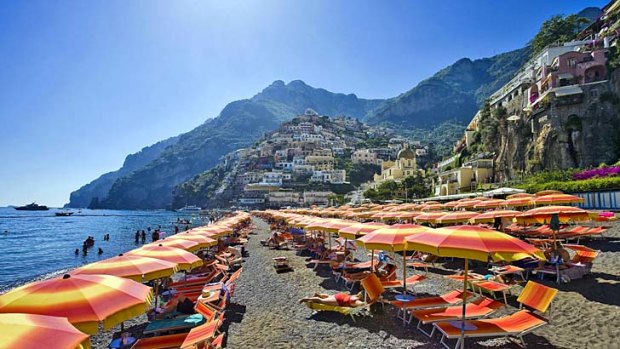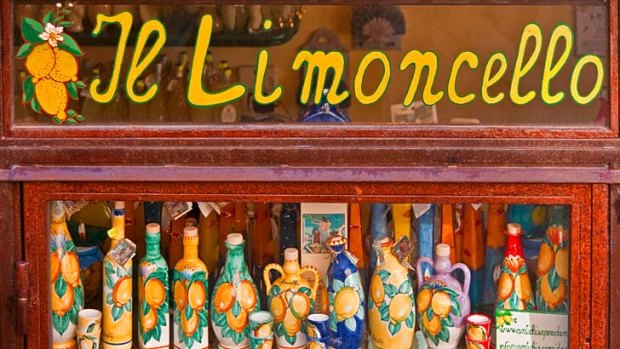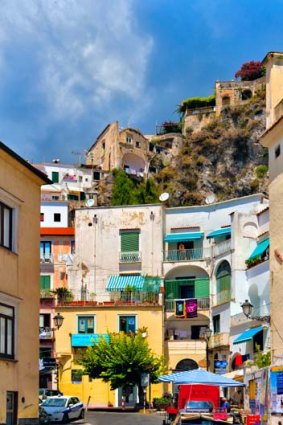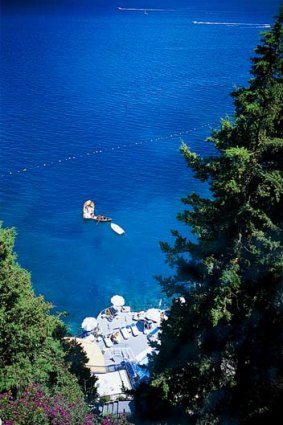
Colours of the coast ... the beach at Positano.Credit: Getty Images
Make the most of Italy's Amalfi Coast with Ute Junker's guide to its best hotels, restaurants and adventures.
It's arguably the most scenic and the most glamorous stretch of coast in Europe: a landscape of towering cliffs covered with lemon trees, olive groves and precariously perched villages studded with luxury hotels and superb restaurants. With so much on offer, it's hard to know where to begin. We've done the hard work for you, defining the Amalfi Coast's best destinations, most luxurious hotels, best places to eat and the best things to do, to help you holiday in style.
Positano: ready for its close-up

Bottles of locally made limoncello in Amalfi.Credit: Alamy
The vibe If you want to understand why Positano is the most-photographed village on the Amalfi Coast, try to arrive by boat. That way, you get to see the town in all its splendour: the hillside that slopes steeply up from the gravelly beach, the yellow, pink and white buildings huddling together as if terrified of tumbling down. It's a gorgeous layout but one that will give your leg muscles a workout.
On the upside, Positano is a very small town. One main street leads from the town to the beach: the rest of town is joined by a latticework of steep staircases. An hour or two is more than enough to explore the town's shops, where you'll find plenty of linen dresses, leather sandals and colourful ceramics.
Where to stay For the best lodgings in town, you'll need to leave town - although only a kilometre or two. You can get to the Hotel Il San Pietro either by road or by boat.

Colourful ... houses at Amalfi.Credit: Alamy
From the road, it's easy to drive past without seeing it: carved into the cliff, the hotel is a discreet hideaway. Approaching by boat, however, you can see how the property cascades down the cliff. Arrayed on different levels are restaurants, tennis courts, a swimming pool and - best of all - a small private beach. The hotel's sun-soaked terraces, covered with bougainvillea blossoms, hibiscus and jasmine, have spectacular sea views, as does each and every one of the 61 rooms, which also feature ceramic-tiled floors and private terraces. If you're in the mood for dinner at the hotel's Michelin-starred restaurant, the same kitchen serves up stellar room service, such as handmade semolina flour pasta with salt cod, broad beans and black truffle. And, whenever you're ready, the complimentary shuttle will take you into town and pick you up again.
Where to eat Positano's seafront is cluttered with restaurants but the most memorable meal is found in the heart of town. On your left as you walk towards the beach, you'll spot a small door that opens onto a garden. This is the Michelin-starred Al Palazzo, Positano's most atmospheric restaurant as well as its best. It has candlelit tables arranged throughout the garden and delicious seasonal dishes such as stuffed zucchini blossoms or sea bass carpaccio. There's also an impressive wine cellar, housed in a converted water tank - ask your waiter if you can take a peek.
Must-do Despite its spectacular setting, Positano's beach is no great shakes. For a real treat, hop onto one of the diminutive local buses (they're kept small to make it around all those hairpin bends) and head for the hills - for the village of Nocelle, to be precise, a place so small it makes Positano look bustling.

Breathtaking ... the view from the Santa Caterina Hotel.
Nocelle is one of the access points for the Sentiero degli Dei, or Path of the Gods, perhaps the most spectacular of the ancient footpaths that criss-cross the hills here. You could start the walk in Positano but you need to climb a lot of steps from Positano to get to Nocelle and the view is just as good from the bus. From Nocelle, the walk heads out into the pristine hillside and from here it's only about two hours until you finish in the village of Bomerano, rather than closer to four.
Walkers enjoy gorgeous views of the coastline and its scalloped bays. Along the way, the terrain changes from lemon groves to scrubby hillsides to shady glens to terraced vineyards. The path itself is just as varied. Sometimes there are stone steps, sometimes there's a wide path, sometimes you find yourself following a mule track. Wear good walking shoes and pace yourself.
And then there's For a more relaxing walk, turn right at Positano's ferry wharf and take the coastal path to Fornillo, Positano's other, more secluded beach. The short, tree-lined walk takes you past a number of fortified towers built as a defence against Saracen pirates, and winds up at Fornillo's inviting beach bars.
Amalfi: culture and cuisine
The vibe As you'd expect of the town from which the coastline takes its name, Amalfi is the local hub. Although it still has a laid-back feel, it's not a place that caters just for tourists: on the long main street that stretches back from the port, you'll find bakers and grocers as well as the usual shoe shops and souvenir stores.
It's a surprise to learn that this pretty town was once a serious player in international politics. Before the rise of Venice, Amalfi - an independent republic for three centuries until 1075 - was one of Europe's great maritime powers, rivalled only by Pisa and Genoa. Although much of the town was destroyed by a tsunami in the 14th century, you'll still get glimpses of its former grandeur.
Where to stay Walking into the Hotel Santa Caterina feels a bit like coming home - not that we've ever lived in an 1850s cliffside mansion, of course. The same family has run the hotel for four generations and they have the effortless hospitality thing down pat, as past guests such as Angelina Jolie and Brad Pitt have discovered (they stayed here while filming Mr & Mrs Smith).
Elegant as the rooms in the original mansion are, the pick of the accommodation is the exquisite garden suites. Our favourite: the lovely Chalet Giulietta e Romeo, set amid orange groves.
The hotel is a 10-minute walk from town, with a shuttle making regular trips for those who don't feel like hoofing it. However, there are plenty of reasons to hole up in the hotel: the Santa Caterina has its own swimming pool, a wellness centre and a choice of restaurants.
The more formal of the hotel's two restaurants, also called the Santa Caterina, is a good choice for dinner: whatever you order, leave enough room for the to-die-for lemon souffle, made with local lemons.
Where to eat Amalfi boasts a number of Michelin-starred restaurants but for creative, well-executed cuisine, Ristorante Eolo is the place to go. With super-fresh seafood, friendly service and a location looking back across the bay (ask for a window table when you book), it hits all the marks. If it's on the menu, order the potato ravioli: that's ravioli made with potato, not ravioli filled with potato. Stuffed with cauliflower cream, sultanas and lemon zest, and served in a light clam and toasted pine nut sauce, it's delicious.
Must-do For some people, the best thing about a seaside holiday is that there are no churches or museums to visit. Even if you're one of them, a visit to the Amalfi Cathedral is a must. The imposing exterior - a wide flight of steps, striped marble facade and ornately tiled dome, on display every time you wander down the main street - is magnificent but it's the interior of this sprawling complex, originally built between the 9th and 11th centuries, that is truly remarkable.
You enter through the quiet Cloister of Paradise, where the town's grandest citizens were once buried. The tranquil Moorish-inspired space has soaring arched columns and fragments of 13th-century Byzantine mosaics on the walls.
Behind that lies the oldest part of the cathedral, the 6th-century basilica, which now houses a small collection of precious objects, including an ancient mitre decorated with 20,000 small pearls as well as rubies and emeralds. From here, take the steps down to the crypt, perhaps the most beautiful part of the cathedral. This stunning space has marble columns with elaborate inlays as well as magnificently frescoed vaulted ceilings.
And then there's A 15-minute stroll along Amalfi's seafront will take you to the small village of Atrani. Tucked in behind a small beach, Atrani has retained its maze-like mediaeval structure, with narrow, vaulted streets and alleys switchbacking among the crowded-together houses. In the summer months when Amalfi's streets are packed with day trippers, Atrani provides a quiet respite.
Capri: island life
The vibe Technically, it's off the Amalfi Coast, rather than on it but it's impossible to talk about the Amalfi Coast without mentioning Capri. Decades as the preferred haunt of Europe's in-crowd have given Capri a glamorous reputation that makes it a magnet for both day trippers and stayers.
On those days when cruise ships are in town, the narrow streets of Capri Town are often thronged with people out to flash some cash in the many designer boutiques. Basing yourself here lets you avoid the crowds and discover the island's other side: the charming town of Anacapri, for instance, or the island's wild heart, which can be explored through a number of walking trails.
Where to stay The Capri Palace, perched in the charming hilltop town of Anacapri, is one of those rare hotels that gets everything right. The public areas, with vaulted ceilings and cosy nooks, manage to be imposing and intimate at the same time. They also showcase the owner's impressive contemporary art collection.
The suites are sumptuous - some come with plunge pools and private terraces - and the spa is world-class. The hotel even has its own beach club, a fantastic place for a seafood lunch and steps away from the Blue Grotto. The complimentary shuttle will ferry you there or into Capri Town.
Where to eat If you're staying at the Capri Palace, you won't have far to go to get to the hotel's best restaurant: it's in the hotel itself. L'Olivo has two Michelin stars and an approach to fine dining that's all its own.
The restaurant feels surprisingly homey - diners can sink into cashmere-covered sofas and drink from hand-blown Murano glasses - and the menu is very flexible. It's divided into four categories - rice and grain; egg, vegetables and soups; fish; and meat - and diners can order any dish on the menu as an entree or main. The seafood is superb. Try the spiny blue lobster risotto with bergamot, peas and marjoram; or the seafood mosaic, nine tiny morsels including amberjack tartare with beetroot cream. Whatever you order, leave room for dessert, the specialty of the house. The ice-cream trolley include options such as olive oil with candied celery, buffalo milk ice-cream with Grand Marnier-scented raspberries, and smoked chocolate.
Must-do The Blue Grotto remains Capri's No.1 attraction but there's a lot more to see on the sea. On Capri Boats' two-hour cruise, in addition to the obligatory Blue Grotto visit you'll get to see the ruins of some of the Emperor Tiberius's 13 palaces, coral growing on cave walls and, if you're lucky, even spot a friendly dolphin or two. Their sleek boats are small enough to take you inside some of the island's prettiest grottoes, including the green and white grottoes.
And then there's Capri has more than brand names and bling, as you'll discover on the two-hour round trip walk from Capri town past the Arco Naturale and the Grotta di Matermania, a trip through the island's untamed heart. Unlike the walks on the mainland, there's no scrambling or climbing involved, although there's no avoiding some stairs.
The well-kept paths, the pine-scented air, the beautiful views and, most of all, the charming little trattorias along the way that coax you into relaxing with a cool drink, and maybe a bite to eat, will convince you that Capri really is a magical place.
The writer was a guest of Leading Hotels of the World and Relais & Chateaux.
Address book
Positano
Ristorante Al Palazzo, 23 Via dei Mulini, +39 089 875 177, ristorantealpalazzo.it. Mains about €30 ($36).
Hotel Il San Pietro, 2 Via Laurito, +39 089 875 455, ilsanpietro.it. Rates start from €420 a night.
Amalfi
Ristorante Eolo, 3 Via P. Comite, +39 089 871 241, eoloamalfi.it. Mains about €30.
Hotel Santa Caterina, 9 S.S. Amalfitana, +39 08 987 1012, hotelsantacaterina.it. Rates start from €290 a night.
Capri
Ristorante l'Olivo. Mains about €45. Located in Capri Palace Hotel and Spa, 14 Via Capodimonte, Anacapri, +39 081 978 0111,capripalace.com. Rooms start from €350 a night.
Capri Boats, capriboats.com.
Trip notes
Getting there
Lufthansa flies from Australia to Naples, connecting via Singapore and Frankfurt. Prices start from $1795 departing from Sydney with partner airline Jetstar. 1300 655 727, lufthansa.com.
When to go
To enjoy the Amalfi Coast at its best, avoid midsummer, when tourists descend by the thousands, hotel rates rise and restaurant reservations are hard to come by. Early May and late September — when the crowds are gone but the weather remains pleasant, with tops around the mid-20s - are the best choices.
More information
Sign up for the Traveller Deals newsletter
Get exclusive travel deals delivered straight to your inbox. Sign up now.